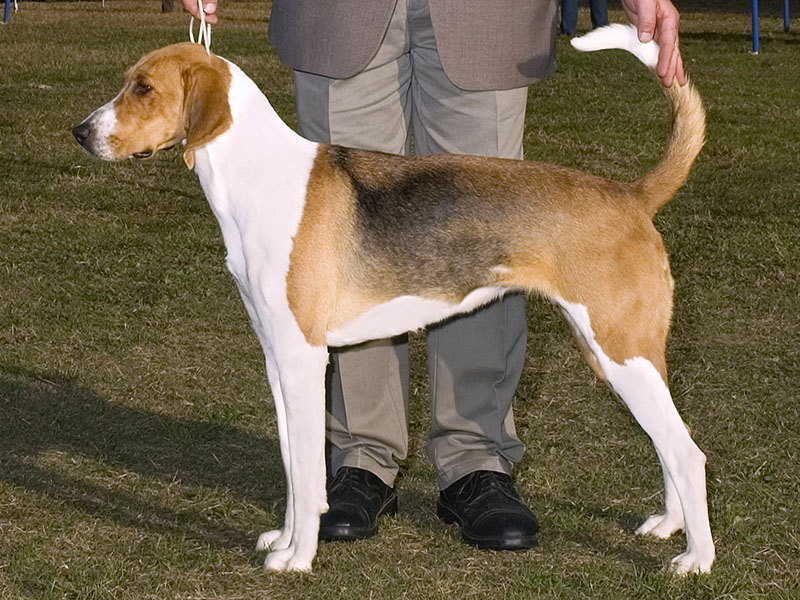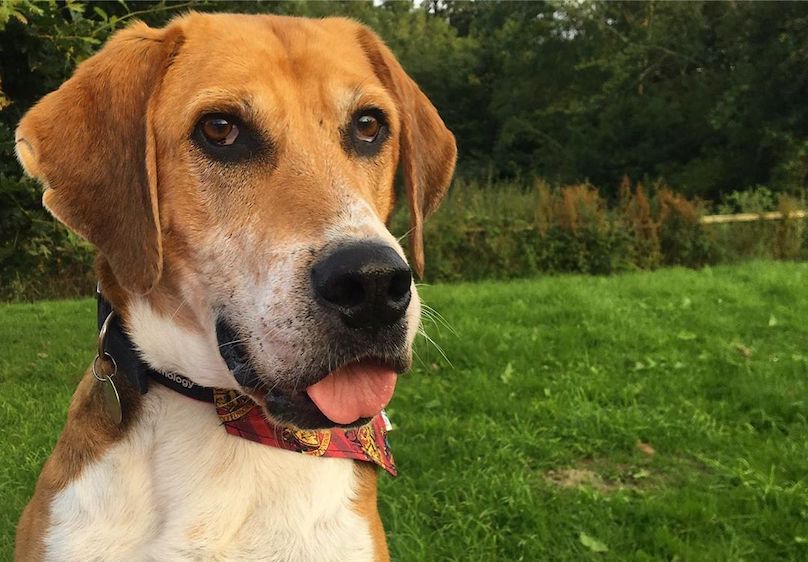
The English Foxhound is a classic British scent hound, developed in England during the 16th and 17th centuries for one purpose: fox hunting. Breeders combined Greyhounds, Staghounds, and various scent hounds to create a durable, fast, and driven pack hound with the stamina to chase foxes over long distances and rough terrain.
Foxhunting was not just a sport but a social institution in Britain, and the English Foxhound was a central figure in it. For centuries, entire packs were bred and maintained by aristocrats and hunting clubs. Although foxhunting has declined, the breed endures and has found homes as a companion dog, show dog, and scent hound in the U.S. and Europe.
The American Kennel Club (AKC) recognized the English Foxhound in 1909, and it remains a symbol of tradition and athleticism.
While less common as a household pet, the English Foxhound is highly valued by hunters, trail riders, and active families who appreciate its endurance and even temperament. It also serves in search and rescue and excels in tracking competitions.
Built for speed, strength, and endurance, the English Foxhound is a muscular and graceful breed with a noble bearing.
• Coat: Short, dense, and weather-resistant—lies flat against the body.
• Color:
o Typically tri-color (black, white, and tan), but also seen in white and tan or lemon and white.
• Size:
o Height: 23–27 inches (58–69 cm)
o Weight: 60–75 lbs (27–34 kg)
• Head & Expression: Broad, slightly domed skull with a strong, square muzzle and large, expressive eyes.
• Ears: Set low and hanging close to the cheeks—soft and rounded at the tips.
• Tail: Moderately long, carried gaily but not curled over the back.
• Body: Deep-chested, straight-backed, and long-legged, designed for continuous motion.
This breed is friendly, determined, and energetic, with a pack mentality and keen nose.
• Energetic and Athletic: Bred for day-long hunts—needs space and exercise.
• Sociable and Affectionate: Gets along well with people and thrives in multi-dog households.
• Independent but Trainable: Can be stubborn, but responds to patient, positive training.
• Vocal: Like most hounds, prone to baying and howling, especially when following a scent.
• Gentle and Easygoing: Has a stable and even temperament, rarely aggressive.

Ideal for active owners or families looking for a good-natured and tireless companion, especially those with space to run.
• Superb Endurance: Can handle hours of physical activity—ideal for trail running, hiking, or horse owners.
• Friendly and Sociable: Rarely aggressive, loves company, good with kids and other dogs.
• Healthy and Hardy: Long-lived and low-maintenance.
• Classic Beauty: A noble, balanced, and timeless canine form.
• Great Nose: Can excel in tracking, scent work, and detection games.
Though easygoing at home, this breed has serious energy needs and a strong prey drive.
• Training:
o Start young—early recall and leash training are crucial.
o May be distracted by scents, so training in low-distraction environments helps.
• Exercise:
o Needs at least 1–2 hours of activity daily.
o Enjoys off-leash running in secure areas or jobs like tracking and hiking.
• Grooming:
o Very low maintenance—brush weekly and bathe as needed.
o Keep nails trimmed and ears clean.
• Nutrition:
o Feed a balanced, high-protein diet suitable for athletic breeds.
o Monitor weight during off-season or less active months.
• Living Conditions:
o Best suited for homes with yards or country settings—not ideal for apartments unless heavily exercised.

The English Foxhound is generally a healthy and long-lived breed, with fewer genetic issues than many other purebreds. Potential concerns include:
• Hip Dysplasia (rare with good breeding)
• Ear Infections (due to floppy ears)
• Bloat (gastric torsion)
• Exercise-Induced Injuries (due to high activity)
With proper care, they typically live 10–13 years, often aging gracefully.
Compared to the American Foxhound, the English version is more solidly built and has a milder temperament. It is less intense than the Harrier, and more independent than the Beagle. While not as laid-back as a Basset Hound, it offers a great mix of classic hound charm and robust energy.
This breed is best for outdoorsy individuals, hunters, equestrians, and scent sport competitors. It’s a great choice for families with space and time for exercise, especially if you enjoy running, hiking, or working with your dog.
However, if you're looking for a low-energy indoor companion or live in a confined space, this breed’s needs may exceed your lifestyle.
United Pet Club can help you find your ideal English Foxhound through adoption networks, trusted breeders, and training resources. Learn how to nurture this noble hound’s instincts and gentle heart while enjoying one of the most enduring breeds in canine history.